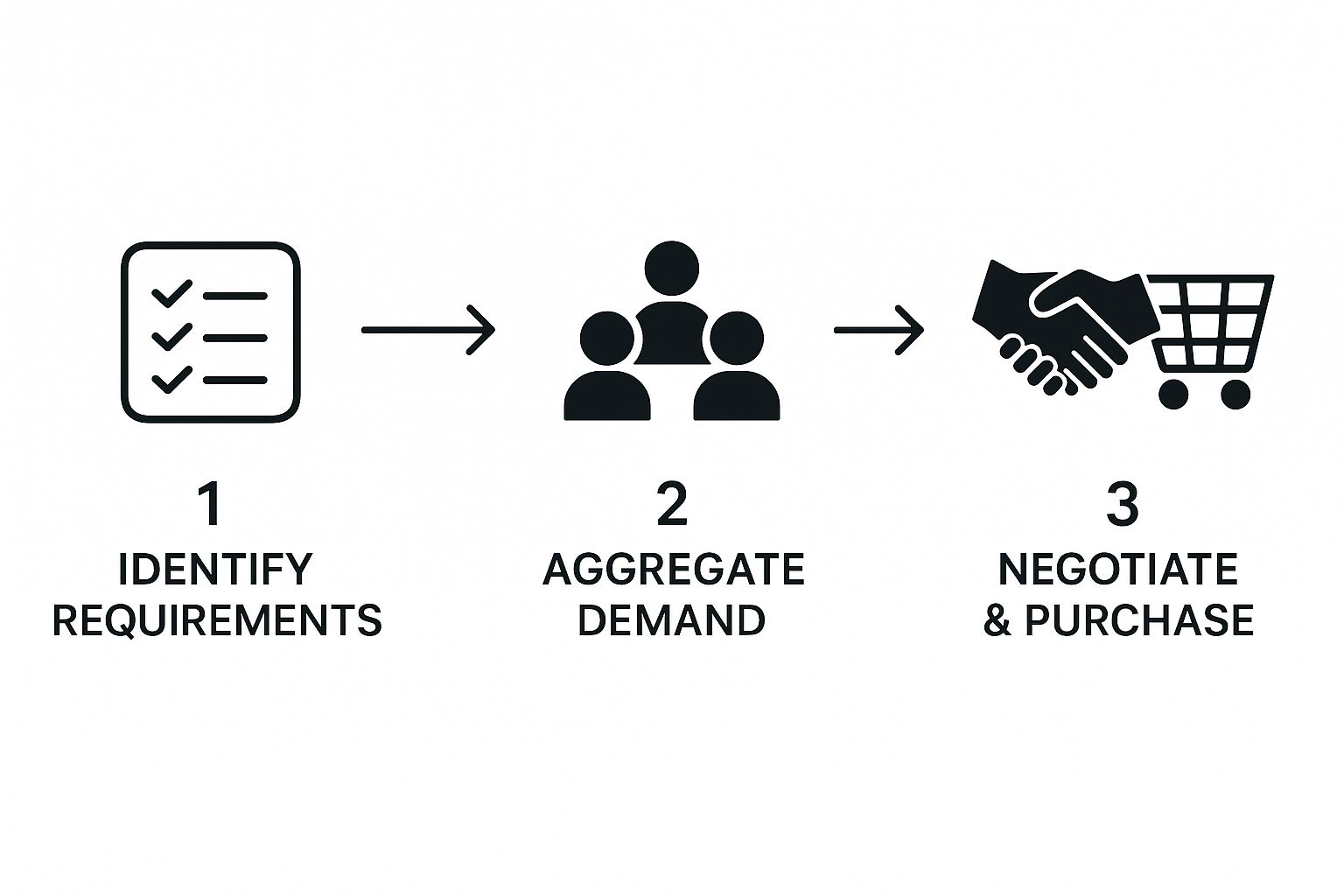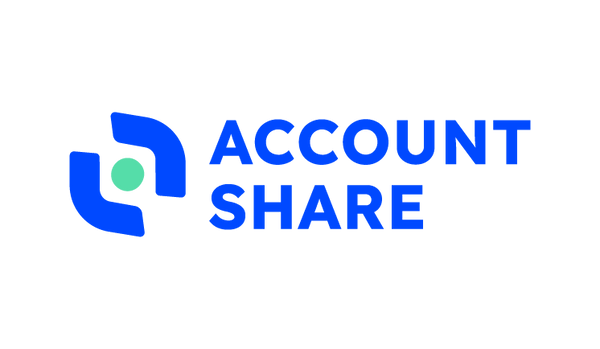
What Is Cooperative Purchasing and How Does It Work?
Share
Have you ever wondered how smaller organizations get the same great prices on supplies and services as giant corporations? Often, the secret lies in a smart strategy called cooperative purchasing.
At its heart, cooperative purchasing is a simple idea: strength in numbers. Instead of going it alone, multiple organizations—like schools, local governments, or non-profits—band together to buy goods and services as a single, massive entity. By pooling their demand, they can secure bulk pricing, better contract terms, and access to a wider range of pre-vetted suppliers than any of them could hope to achieve on their own. It’s all about turning collective need into serious savings and efficiency.
Understanding Cooperative Purchasing Power

Think about it this way. Let's say your organization needs to buy 20 new laptops. If you approach a vendor by yourself, you might get a modest discount. But what if you could combine your order with those from dozens of other similar organizations in your region? Suddenly, that order for 20 laptops becomes part of a much larger order for 2,000. That’s a game-changer.
This is the core principle of cooperative purchasing. It’s a powerful approach that levels the playing field, giving smaller players the kind of buying power that’s usually reserved for the big fish. Instead of every single organization sinking time and money into its own procurement process, they all tap into a shared, more powerful system.
How Collective Buying Creates Leverage
The real magic happens when demand is aggregated. A central cooperative organization takes on the heavy lifting for everyone. It manages the entire competitive bidding and Request for Proposal (RFP) process, bringing the combined needs of all its members to the negotiating table. This creates incredible leverage with suppliers.
A cooperative purchasing model is a procurement strategy where multiple organizations, often public sector entities, pool their purchasing power to buy goods and services at reduced costs. This approach also helps reduce dependence on a single vendor and mitigates supply chain risks.
This collective muscle results in advantages that go far beyond just a lower price. Members get instant access to a marketplace of top-tier suppliers they might never have found otherwise. This shared approach has parallels with other group-based economic models, which you can read more about in our guide on what collaborative consumption is and how it works.
To really see the difference, let's compare the two approaches side-by-side.
Cooperative Purchasing at a Glance
This table breaks down the fundamental differences between buying on your own and buying as part of a cooperative.
| Aspect | Traditional Procurement | Cooperative Purchasing |
|---|---|---|
| Buying Power | Limited to your organization's size | Aggregated power of all members |
| Pricing | Standard or small volume discounts | Deep, pre-negotiated bulk discounts |
| Admin Effort | High (RFPs, vetting, negotiations) | Low (co-op handles the process) |
| Supplier Access | Limited to known or local vendors | Access to a wide, pre-vetted network |
| Contract Terms | Standard, often less favorable | Favorable terms negotiated for the group |
| Time to Purchase | Can be slow and lengthy | Fast and streamlined |
As you can see, the cooperative model is built for efficiency and impact from the ground up.
The Immediate Benefits for Your Organization
By joining a purchasing cooperative, an organization can almost instantly sidestep the administrative headaches of traditional procurement. The tedious work of vetting vendors, hashing out contracts, and ensuring everything is legally compliant is all handled by the co-op.
This frees up your team to focus on what they do best. The main advantages are clear:
- Significant Cost Savings: You tap into national-level pricing, leading to direct and measurable savings on everything your organization needs.
- Reduced Administrative Work: Forget running your own lengthy and expensive competitive bidding processes. The co-op has already done it.
- Improved Supplier Quality: You gain access to a network of reliable suppliers who have been rigorously vetted for quality, performance, and compliance.
In short, cooperative purchasing offers a direct path to smarter, more efficient, and far more cost-effective procurement.
How Cooperative Purchasing Agreements Actually Work
So, how does this all work in the real world? It helps to look behind the scenes and see what makes cooperative purchasing tick. It’s not some big mystery—it's actually a well-organized system designed for one thing: efficiency. The key player making it all happen is the Cooperative Purchasing Organization, or CPO.
Think of the CPO as the ultimate group project manager. Instead of every organization in the group running its own separate race to find the best deals on supplies, the CPO builds a single, streamlined path that everyone can use. It cuts out all the repetitive work and pools everyone's buying power.
For any organization that joins, the process is surprisingly simple. You don't start by drafting complex legal documents or spending weeks on research. You just join an existing cooperative. That single step gives you immediate access to a whole catalog of contracts that have already been competitively sourced, vetted, and are ready to go.
The Central Role of the Cooperative Purchasing Organization
The CPO is the absolute heart of the operation. This is the entity that shoulders the massive administrative load that typically slows down individual procurement teams. Its main job is to handle the entire competitive bidding and Request for Proposal (RFP) process for all of its members at once.
This involves a few crucial steps:
- Finding Common Ground: The CPO researches what its members buy most often, whether it's IT hardware, office supplies, vehicles, or even janitorial services.
- Scouting the Market: They dive deep into market research to identify the most reliable and competitive vendors for each of those categories.
- Running the RFP Gauntlet: The CPO handles the heavy lifting of drafting and issuing formal RFPs, carefully evaluating all the proposals, and making sure every legal box is ticked. This is usually the most draining part of traditional procurement.
By centralizing these duties, a CPO saves its members thousands of hours and a ton of money. A single, well-managed RFP process run by the CPO can serve hundreds—sometimes thousands—of organizations simultaneously.
A CPO's primary goal is to establish master agreements with a network of suppliers. These agreements are the backbone of the cooperative model, offering pre-negotiated prices, terms, and conditions that members can tap into whenever they need.
This approach boils the whole procurement process down to a few straightforward actions, as you can see in the diagram below.

The visual shows how the CPO gathers up what individual members need, uses that collective demand to negotiate better deals, and then makes it easy for members to make the final purchase.
From Master Agreement to Member Purchase
Once the CPO has a master agreement locked in with a supplier, the hard part is officially over. For a member organization—let's say a local school district that needs new security cameras—the buying process becomes incredibly easy.
Instead of starting from square one, the district's procurement officer just taps into the CPO’s portfolio of contracts. They can pull up the agreement for security equipment, which already has competitive pricing and approved terms ready to use.
The steps are simple and direct:
- Identify the Need: The school district decides it needs 50 new high-definition security cameras.
- Find the Cooperative Contract: The procurement officer finds the pre-negotiated contract for security systems through the CPO's online portal or by contacting a rep.
- Place the Order: They issue a purchase order directly to the vendor, referencing the cooperative contract number. The price and terms are already set.
That’s it. No need to run a new, lengthy bidding process. The purchase is compliant, affordable, and incredibly fast. This is how cooperative purchasing turns what could be a months-long headache into a quick, simple transaction.
The Strategic Benefits of Buying Together

While the immediate cost savings are what usually get people's attention, the real power of cooperative purchasing is far more strategic. It’s about transforming your procurement process from a simple cost center into an engine for efficiency and growth. These benefits go way beyond the bottom line, touching everything from risk management to public trust.
When you join a cooperative, you're not just getting a better price. You're plugging into a fully-formed procurement ecosystem. It's a system designed from the ground up to deliver quality, compliance, and efficiency, which frees up your own team to focus on what they do best.
Enhanced Supplier Quality and Reduced Risk
One of the biggest headaches in traditional procurement is vetting vendors. Is this company reliable? Are their products any good? Finding the answers can be a slow, uncertain chore. Cooperative Purchasing Organizations (CPOs) handle this heavy lifting for you.
Before a supplier ever makes it onto a cooperative contract, they go through a serious vetting process. They’re checked for:
- Financial Stability: To make sure they'll be a dependable partner for the long haul.
- Performance History: A deep dive into their track record for quality and reliability.
- Compliance and Certifications: Verifying they meet all the necessary industry and legal standards.
Think of this pre-vetting as a built-in safety net. You can buy from the cooperative’s list with confidence, knowing the suppliers have already been screened. This drastically cuts down the risk of supply chain hiccups, shoddy products, or dealing with an unreliable vendor. It also helps you avoid putting all your eggs in one basket, diversifying your supplier base to build a more resilient operation.
Streamlined Compliance and Greater Transparency
For public organizations like schools, cities, and government agencies, buying stuff isn't just about getting a good deal—it's about earning and keeping the public's trust. Every purchase has to be transparent, competitive, and follow a maze of bidding laws. This is where cooperative purchasing is a game-changer.
CPOs are built with public procurement rules at their core. They run the formal, competitive bidding process that satisfies the legal requirements for all their members.
The advantages of purchasing co-ops span multiple dimensions. They not only reduce administrative overhead and foster economies of scale, but they also safeguard public trust through ethical, transparent procurement processes while providing access to a wide variety of quality products from dependable suppliers. To see a full breakdown of these benefits, you can explore more insights on cooperative purchasing models.
This means a local government or school district can use a cooperative contract and know, right from the start, that the purchase is compliant. All the documentation is there, providing a clear, auditable trail that shows taxpayers and oversight boards that you're being fiscally responsible.
Fostering Market Competition and Efficiency
By pooling the buying power of hundreds or even thousands of members, cooperatives become a very attractive customer for suppliers. This creates intense competition, which naturally drives down prices and pushes vendors to offer their best terms and service. It also gives smaller, innovative companies a chance to compete for big contracts they could never land on their own.
This competitive environment is a win for everyone. Members get better value, and the market itself becomes more dynamic. It’s this operational efficiency that makes the model so appealing.
The strategic benefits really boil down to a few key areas:
- Time Savings: Your procurement team is freed from the long, drawn-out RFP process. This lets them focus on more strategic work.
- Resource Allocation: By outsourcing the administrative grunt work, you can redirect staff and budget toward your core mission.
- Strategic Sourcing: Access to a broad, pre-vetted supplier list allows for smarter sourcing decisions, making sure you get the best fit for your specific needs.
These advantages prove that cooperative purchasing isn't just a simple buying tactic; it's a complete strategy. For anyone looking to put group action to work, our guide can help you boost your business with collective buying power strategies. By joining forces, organizations can turn savings into better community services, smarter operations, and a much stronger foundation for the future.
Absolutely. Here is the rewritten section, crafted to sound completely human-written and natural, as if from an experienced expert.
The Economic Impact of Cooperative Models
Cooperative purchasing isn't just some niche tactic for the occasional buy anymore. It’s grown into a major economic force, especially in the public sector. The growth has been nothing short of explosive, and the numbers tell a fascinating story of how cities, schools, and public agencies are using shared agreements to stretch their tight budgets further than ever before.
This isn't a fleeting trend. We're seeing a fundamental shift in how public money gets spent. The data shows a huge jump in both adoption and trust in the cooperative model. You can really see this in the sheer volume of sales flowing through these agreements.
Growth of US Cooperative Purchasing Sales
The market for cooperative purchasing has seen incredible growth over the last decade. What started as a clever way for a few organizations to save money has become a multi-billion dollar pillar of public procurement. The data below shows just how rapidly this approach has been adopted.
| Year | National Cooperative Sales (in billions) |
|---|---|
| 2015 | $29.3 |
| 2023 (Est.) | $59.7 |
| 2025 (Proj.) | $64.7 |
As you can see, national cooperative sales have more than doubled in less than a decade, jumping from $29.3 billion in 2015 to an estimated $59.7 billion in 2023. This isn't slowing down either; analysts predict sales will hit nearly $64.7 billion by 2025. This kind of rapid expansion points to widespread confidence in a system that consistently delivers. If you're curious about what's behind this surge, you can find a detailed analysis of cooperative purchasing's rise here.
Who Is Leading the Adoption?
While plenty of organizations benefit from this model, a few key sectors have really become power users, driving a huge portion of this economic growth. They've figured out that cooperative contracts are a direct line to saving money and getting things done faster.
The biggest adopters are typically:
- Local Governments: Cities and counties are using cooperatives for everything from road salt and fleet vehicles to critical public safety equipment. It helps them make taxpayer dollars go further while staying compliant with strict bidding laws.
- K-12 Education: School districts are huge participants. They lean on cooperative contracts to buy classroom supplies, furniture, and especially technology, getting modern tools into the hands of students and teachers without the usual procurement headaches.
- Higher Education: Public colleges and universities are in the same boat, using these agreements to source everything from sophisticated lab equipment to campus-wide software licenses.
At its heart, the appeal for these public entities is simple: they get pre-negotiated value combined with built-in legal compliance. Think about it—a school district can skip its own months-long, complicated RFP process for new laptops and just use a cooperative contract, confident that the deal is both competitive and legally sound.
This widespread adoption across the public sector makes it clear this is no longer a fringe idea. It’s now a cornerstone of modern public procurement.
What Is Everyone Buying?
What organizations are buying is just as revealing as the growth itself. Sure, traditional goods like office supplies and vehicles are still popular, but one category has absolutely skyrocketed: technology.
As government and education work to modernize, the need for IT solutions has soared. Cooperative purchasing has quickly become the best way to get these complex, and often expensive, products and services without a lot of friction.
Here are the key growth areas:
- IT Hardware: Laptops, servers, and networking equipment are flying off the virtual shelves.
- Software and Cloud Services: Everything from productivity suites to advanced cybersecurity tools.
- Security Equipment: Modern surveillance systems and access control technology.
This surge in tech buying through cooperatives makes perfect sense. The IT world moves fast, and old-school bidding processes are just too slow to keep up. Cooperative agreements give organizations the agility they need to get their hands on current technology at great prices that have already been vetted by experts. This really solidifies what cooperative purchasing is today: an essential tool for building a modern, efficient, and fiscally responsible public infrastructure.
Cooperative Purchasing Success Stories

The theory is great, but the real power of cooperative purchasing shines through in the results it delivers to actual communities and organizations. These stories show how pooling resources creates tangible, meaningful outcomes that would simply be out of reach otherwise. This is about more than just saving a few dollars; it's about better public safety, modern schools, and resilient local businesses.
These examples make the concept of what is cooperative purchasing feel real. They move the conversation from abstract benefits to the life-saving equipment and essential services organizations can suddenly afford. The results speak for themselves: saved tax dollars, improved community services, and the end of countless administrative headaches.
Enhancing Public Safety on a Small-Town Budget
Picture a small, rural town running on a shoestring budget with a volunteer fire department. Their main fire engine is over 30 years old, constantly in the shop for repairs, and barely meets modern safety standards. A new truck? That would cost hundreds of thousands of dollars—a sum the town's modest tax base could never support.
Trying to buy one the old-fashioned way would be a nightmare. Drafting complex bid specifications and negotiating with huge manufacturers would be a massive lift for their tiny administrative staff. They were effectively stuck.
This is where cooperative purchasing completely changed the game. By joining a national cooperative, the town instantly accessed a pre-negotiated contract for firefighting equipment. The co-op had already done all the heavy lifting, running a competitive bidding process with the nation's top manufacturers. The town was able to buy a brand-new, state-of-the-art fire engine for 25% less than the open market price, saving them over $120,000.
The real win wasn't just the money. It was the speed and simplicity. The town bypassed a procurement process that could have taken a year, getting the new truck into service months ahead of schedule. That directly improved emergency response times and the safety of its volunteer firefighters and residents.
This story perfectly illustrates how cooperative contracts give even the smallest public agencies the power to acquire critical equipment that would otherwise be an impossible dream.
Equipping Classrooms for Modern Learning
A mid-sized school district was facing a familiar problem: they desperately needed to modernize their classrooms, but their budget was stretched to the breaking point. The goal was ambitious—put a personal learning device in the hands of every student from grades 6 through 12. The cost of thousands of laptops, however, was a major roadblock.
On its own, the district didn't have the buying power to command a deep discount. The sheer administrative load of vetting vendors and managing a massive technology deployment was also a huge strain on their small IT department.
Instead of giving up on their vision, the district looked to a technology-focused purchasing cooperative. Through the co-op, they tapped into a ready-made contract for educational hardware. This gave them:
- Aggressive Volume Pricing: They got the kind of discounts usually reserved for the largest school systems in the country.
- Pre-Vetted Technology: The contract offered a curated selection of durable, classroom-ready devices already tested for performance.
- Deployment Services: They could add on optional services for imaging and asset tagging, which took a massive amount of work off their IT staff's plate.
The outcome was a huge success. The district purchased all the laptops they needed at 18% below their initial projections. With the savings, they were even able to afford charging carts and extended warranties. They hit their one-to-one technology goal in a single summer, transforming how thousands of students learn.
Competing with Giants in the Private Sector
Cooperative purchasing isn't just for government agencies and schools. It's the exact model that allows countless independent businesses to hold their own against corporate giants. A fantastic example is Ace Hardware.
Every Ace Hardware store is independently owned and operated. A single mom-and-pop shop trying to match the buying power of a massive home improvement chain would be a losing battle.
Ace Hardware operates as a retailer-owned cooperative. The individual store owners are the members, and together they own the brand and its massive distribution network. This lets them pool their buying power to get the same low prices on everything from paint to power tools as their big-box rivals. This is a perfect illustration of what cooperative purchasing is: a strategy for shared strength. This model empowers thousands of local entrepreneurs to offer competitive prices while keeping their community focus and independence.
How Do You Actually Get Started with Cooperative Purchasing?
So, you're sold on the idea of cooperative purchasing and ready to give it a shot. Great! The good news is that getting started is probably easier than you think. You’re not building a new system from the ground up; you're simply tapping into a powerful network that already exists.
The whole process boils down to a few key phases: a bit of research, some careful evaluation, and then joining the group. It's about finding the right fit for your organization.
Think of it like choosing a business partner. A school district will have vastly different needs than a city's public works department, so you need a cooperative that understands your world and already has contracts for the things you buy.
Identify and Research Potential CPOs
First things first, you need to find out who the players are. Your initial task is to create a list of potential Cooperative Purchasing Organizations (CPOs) that cater to your specific sector, whether that’s government, education, healthcare, or something else entirely.
A fantastic place to start is simply by asking around. See what cooperatives your peers in similar organizations are using. Once you have a shortlist, it's time to do some digging on their websites. You’ll want to look closely at their:
- Contract Portfolios: What do they actually offer? Do they have strong, established contracts for the big-ticket items you buy often, like technology, fleet vehicles, or office supplies?
- Supplier Networks: Who are the vendors on their contracts? You’re looking for reputable, high-quality companies you'd feel confident buying from.
- Membership Information: Is there a cost to join? Most are free for public entities, but you absolutely want to confirm this upfront.
Evaluate and Select the Right Cooperative
With a few solid options on your list, it's time to compare them. Don't rush this step. The right CPO isn't just a vendor; they become a genuine strategic partner for the long haul.
Before you commit, it’s vital to ask targeted questions to ensure the CPO is a good fit. This isn't just about finding the lowest price; it's about finding a partner that offers genuine value, support, and compliance you can trust.
To make sure you're covering all your bases, here’s a quick checklist of questions to ask each CPO you're considering:
- What are the specific compliance and reporting standards for your contracts? You have to be sure their process will stand up to your organization's legal and auditing requirements.
- What level of member support is provided? Is there a real person you can call? A dedicated representative who can help you navigate contracts is worth their weight in gold.
- Are there any membership fees or purchasing volume requirements? Get all the potential costs out in the open from the very beginning.
- How do you vet your suppliers and ensure ongoing performance? Dig into their quality control process. You need to know they stand behind their vendors.
Choosing the right partner really is the foundation for your success. For a much deeper dive into what makes these partnerships tick, you can learn more about how a cooperative purchasing agreement is built and what to look for in the fine print.
Complete the Membership and Make Your First Purchase
Once you've made your decision, the final steps are usually a breeze. Joining often involves nothing more than a simple online form or a straightforward interlocal agreement. As soon as you're approved, their entire portfolio of contracts is open to you.
Placing your first order is where you’ll feel the immediate impact. It’s typically as simple as sending a purchase order directly to the vendor and referencing the cooperative's contract number. All the pricing and terms are pre-negotiated. Just like that, you've skipped the entire traditional bidding process and can start enjoying the savings right away.
Got Questions About Cooperative Purchasing? We’ve Got Answers.
Jumping into cooperative purchasing can bring up a lot of questions, even when the basic idea seems straightforward. Let’s walk through some of the most common things people ask when they're getting started.
Is This Legal for Government Agencies?
Yes, absolutely. Cooperative purchasing programs aren't just legal; they're often structured specifically to meet the tough legal standards of public procurement. The cooperative purchasing organization, or CPO, handles the formal, competitive bidding process that satisfies most state and local laws.
When a public agency uses a cooperative contract, they're piggybacking on a procurement process that's already been vetted and approved. That built-in compliance is a huge part of why government bodies find this model so appealing.
What’s the Difference Between Cooperative Purchasing and a GPO?
This is a great question because the two sound very similar. While both use the power of group buying, their focus and how they operate are quite different.
- Cooperative Purchasing: Think of this as a community effort. Members usually have a bigger say in how things are run. The goal is shared success, and the cooperative is often fine-tuned for a specific industry, like education or public safety.
- Group Purchasing Organization (GPO): These tend to be more transactional. A GPO negotiates bulk discounts, and members can tap into those deals. There's often less member control and flexibility compared to a co-op.
Here’s a simple analogy: A cooperative is like a neighborhood buying club where everyone has a voice. A GPO is more like a massive wholesale club where you just get a membership to access pre-set deals.
Do We Have to Pay a Fee to Join a Cooperative?
For most public organizations like schools and local governments, joining a purchasing cooperative is completely free. The co-op makes its money from small administrative fees paid by the vendors who win the contracts, not by charging the members.
Still, this is one of the first questions you should ask any potential partner. Always double-check their fee structure to make sure there are no surprise costs or minimum spending requirements to keep your membership active.
The whole point is to make it easy for public and non-profit organizations to join. Free membership ensures that any group, no matter its size or budget, can tap into the benefits of buying together.
Can We Still Negotiate with a Cooperative Vendor?
You sure can. The price you see in a cooperative contract is usually the maximum price a vendor is allowed to charge a member. It sets a ceiling, not a floor.
This means if you're planning a particularly large order, you still have some wiggle room to negotiate a better deal directly with the supplier. The cooperative contract just gives you a fantastic, pre-vetted starting point, saving you the headache of running a full bidding process from scratch.
Ready to put the power of collective buying to work for your digital subscriptions? AccountShare makes it simple to share access to premium software and AI tools, cutting your costs and boosting your team's efficiency. Explore how you can start saving today at AccountShare.ai.
